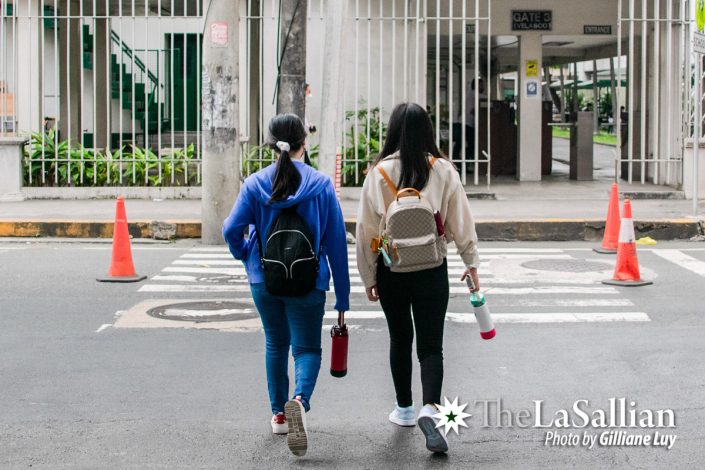Walking along the busy streets of Metro Manila seems like a task that only the brave can conquer, and yet most of the population continues to travel the metro on foot despite the challenges they face in a car-centric society.
Even then, while pedestrians are indeed the majority, their realities and woes go unnoticed by those with authority as the city’s development is geared to cater to car owners.

A stroll along reality
There are various reasons why people opt to walk instead of using cars or any form of public transport. As someone who regularly walked to school throughout high school, Richie Puente (II, AB-PSM) reveals that he started walking due to his lack of finances and his inexperience in commuting. On the contrary, Riz Comia, a long-time pedestrian and member of mobility group Move As One Coalition, explains that she finds walking more practical, given the circumstances she grew up with.
“It’s very typical for me to walk several kilometers to places just because I’m used to things being within reach of my feet. It’s more convenient because I enjoy walking, and I don’t own any other means of transport except [for] my own two feet,” she shares.
While some might find walking to be a nuisance, some are able to find joy when wandering along the city sidewalks. Puente finds walking therapeutic, treating it as a form of meditation. Meanwhile, Comia expresses her appreciation for the opportunities she comes across by walking, from active socialization to promoting physical welfare. “It gives me the opportunity to see other people as well as exercise, [since] walking and commuting are the main physical activities that I’ve been able to do. It’s like the ‘gym of life’ for me,” she expounds.
Pedestrians are bound to run into problems brought about by the government’s decisions that lean toward car-centrism. In Comia’s disheartened words, “[There’s] always that feeling of not being prioritized as someone, as a pedestrian.”
Expressing her frustrations on behalf of people with disabilities, she recounts, “I have had to walk alongside and assist friends who use wheelchairs so that they could cross safely or get from one place to another in one piece.” Comia also illustrates the reality that many young women face when walking, with issues ranging from the fear of walking along dark and narrow streets alone to sexual harassment. “I always feel unsafe walking in front of groups of men because I [often] get catcalled…more often when I was younger actually,” she adds.
Roadblocks ahead
The difficulties in walking to places in Metro Manila is not just an individual problem. It’s a product of people and policy—one that starts with glorifying the possession of a private car. “Previous generations designed our success around owning a car,” Puente remarks. “There was glorification with owning a car as being that line where you’re comfortable.”
Related to this view is what Comia describes as a stigma around walking. “I think a lot of people believe that walking, biking, or commuting to places means you’re poorer, that you can’t afford a car or a Grab [so] you have to resort to cost-free things like walking and cycling,” she notes. “I’ve had students whose dream was to own a car because they felt like…it’s the ultimate level of proving your status.”
Car-centrism lives and breathes not only in the minds of people, but in the infrastructure they inhabit. Like transport groups in the past, Comia claims that most national budgets for transportation go to car-centric infrastructure instead of mass transit. “The more lanes, the more budget, and the more policies that you allot for cars…the more people will be induced to buy cars and use up the lanes that you opened up for them,” she laments.
As cars transport fewer people but occupy more road space, they are largely to blame for the chronic metro traffic. Public transportation and pedestrian infrastructure that move more people get put on the budget backburner, creating inaccessible, unpleasant experiences for many. Move As One Coalition even estimates that 70 percent of road users in Metro Manila rely on public transportation but are packed into only 22 percent of road space. “Certain roads aren’t meant for sidewalks anymore. They (the government) decided to just focus on cars,” Puente observes.
Forward strides
Yet as long as there are individuals and organized groups dedicated to lobbying for a pedestrian-friendly country, the unheard masses can hope for a safe and walkable metro in the future.
Comia acknowledges that transport groups have successfully lobbied for billions to be allocated to the national budget for pedestrian infrastructure and bike lanes in metro areas. Cyclists have also made small but significant strides in lobbying for proper road signs and right-of-way enforcement within their communities—an advocacy that even the average citizen can promote. “For us to get a future where more Filipinos are walking further distances, we have to make conscious choices to prioritize pedestrian, active, and public transport infrastructure in our budgets and in actual implementation,” she declares.
Still, changing people and policy will be an uphill battle. In the meantime, Puente advises pedestrians to stay safe when walking in urban places. “Separate your valuables and keep them in the safest part of your bag. If you are ever approached or robbed, remember that the best self-defense is giving away your items,” he cautions.
Puente’s advice hints at a sobering reality: while a student’s ability to walk to school safely and pleasantly is a right to their education, it remains a faraway dream for many. Nevertheless, there is an overwhelming motive to step forward and turn the dream into reality. “Lahat tayo,” Comia proclaims, “[ay] may karapatan sa mobilidad na may dignidad.”
(All of us have the right to mobility with dignity.)
